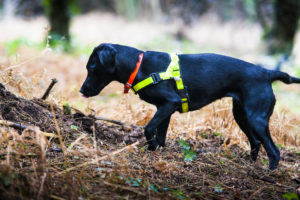Among the many important jobs held by dogs today, conservation work is a small but crucial niche. Conservation dogs are trained to find wildlife and plant samples using modified search & rescue and narcotic techniques. The perfect dog for the job is high energy with a compulsive play drive and toy focus—the more, the better. (Many conservation dogs are shelter rescues, given up by families who couldn’t cope with an always-on dog.) This drive is necessary both for the high-level training and for working in the field alongside biologists and wildlife researchers roughly 300 days out of the year.
One primary job function of conservation dogs is finding wildlife scat and hair. To a biologist, such samples are treasure troves of information, revealing—through DNA analyses—a species’ presence, population size, reproductive status, and food habits. Other vital jobs include searching out invasive species (such as yellow star thistle, a weed that overruns native plants and can kill horses), and endangered species (e.g. Kincaid’s lupine, a near-extinct plant that is also the one place where the rare Fender’s blue butterfly lays its eggs). For more about conservation dogs, visit wd4c.org, the online home of Working Dogs for Conservation.


